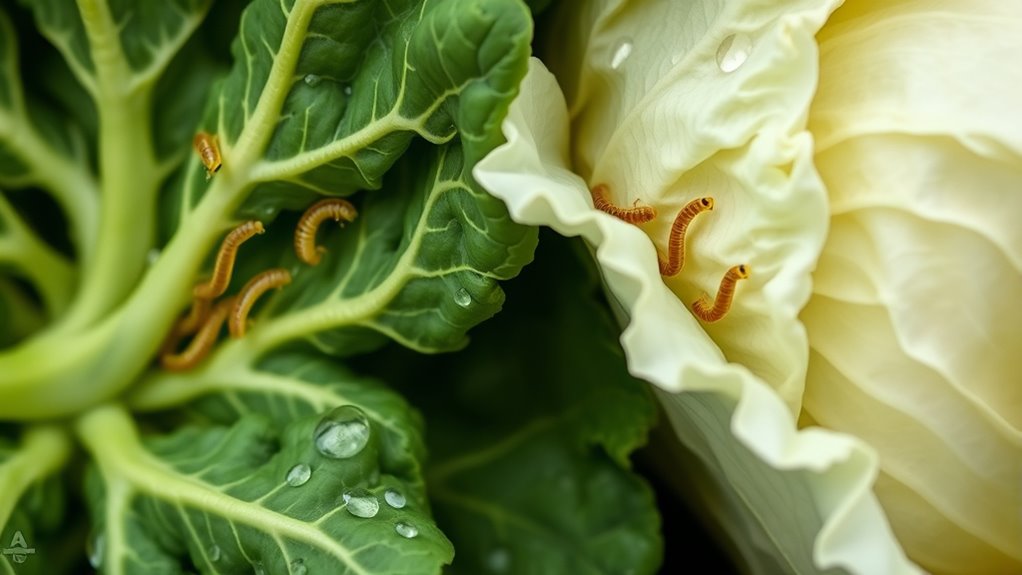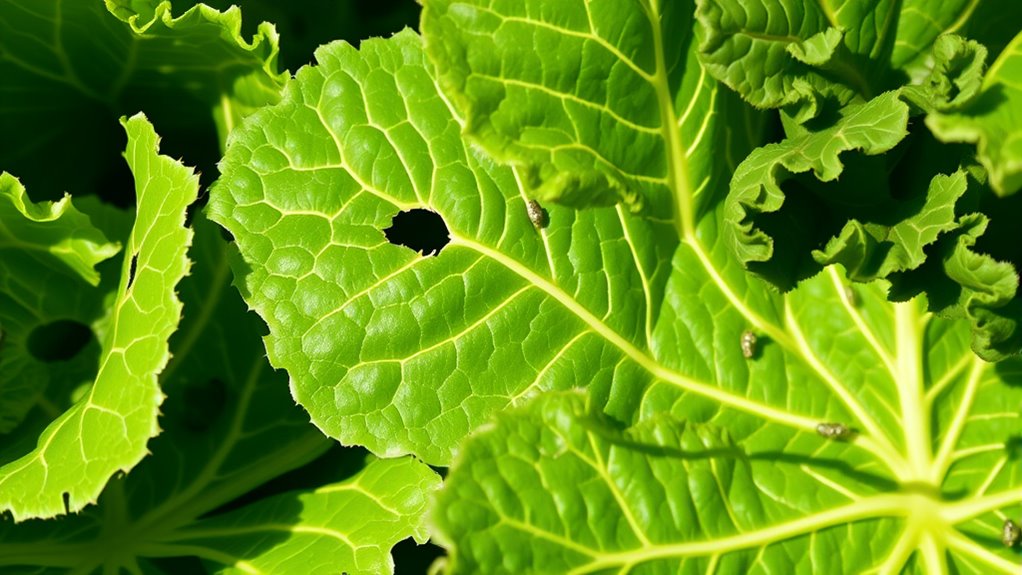Cabbage usually faces more cabbageworm pressure than kale because its tender leaves and scent attract pests, making it a prime target. Kale’s tougher leaves naturally resist some pest attacks, so you often deal with fewer worms. To minimize issues, use row covers, inspect leaves regularly, and encourage beneficial insects. Want to know more about effective pest management strategies? Keep exploring how to protect your crops best.
Key Takeaways
- Cabbage attracts more cabbageworms due to tender leaves and scent, increasing pest pressure compared to kale.
- Kale’s tougher leaves offer natural resistance, resulting in generally lower cabbageworm infestations.
- Regular inspection and organic controls like Bt are essential for managing cabbageworm on both crops.
- Using row covers early in the season effectively reduces cabbageworm egg-laying on both plants.
- Proper crop rotation and garden hygiene help minimize cabbageworm buildup and pest pressure.

When comparing cabbage and kale, both leafy greens pack a nutritious punch and offer unique benefits. However, if you’re concerned about pest resistance, particularly cabbageworm pressure, understanding how each crop responds can help you decide which to grow. Cabbage generally attracts more cabbageworms than kale because of its tender leaves and appealing scent, making pest management a key factor in your growing techniques. Regular inspection is indispensable; check the undersides of leaves for eggs or larvae and remove them promptly. Using organic controls like Bacillus thuringiensis (Bt) can target caterpillars without harming other beneficial insects. Proper crop rotation also helps reduce pest buildup, preventing cabbageworms from establishing a foothold year after year. Ensuring good air circulation and avoiding overwatering can reduce the likelihood of fungal issues that often compound pest problems.
Growing techniques play a essential role in minimizing pest issues. For cabbage, implementing row covers early in the season can effectively block cabbageworms from laying eggs on the leaves. Proactive measures such as physical barriers, crop rotation, and timely organic treatments are essential to combat cabbageworm pressure. Kale’s tougher leaves offer some natural resistance, but pests still pose a threat. Growing techniques such as spacing plants adequately allow for better airflow, reducing the chances of pest infestations. Covering kale plants with floating row covers during peak cabbageworm season can prevent eggs from being laid. Additionally, encouraging beneficial insects like parasitic wasps can help keep pest populations in check naturally. Since kale is generally more pest-resistant, you might find that it requires fewer interventions, making it a more manageable crop if pest pressure is a primary concern.
In terms of pest resistance, your choice of growing techniques can make a significant difference. For cabbage, proactive measures like physical barriers, crop rotation, and timely organic treatments are essential to combat cabbageworm pressure. Kale’s natural defenses mean it’s often more forgiving, but you should still maintain good garden hygiene and monitor regularly. Both crops benefit from healthy soil and proper fertilization, which bolster their overall resilience against pests. Ultimately, your success depends on understanding the specific pest pressures in your area and tailoring your growing techniques accordingly. Whether you grow cabbage or kale, staying vigilant and adopting integrated pest management strategies will help you enjoy a healthy, pest-free harvest.
Frequently Asked Questions
How Can I Differentiate Between Cabbageworm and Other Pest Damages?
To differentiate cabbageworm damage from other pests, look for distinct signs like small, irregular leaf holes and frass (caterpillar droppings). Cabbageworms often create smooth, small holes and may be found on the underside of leaves. Other pests, like aphids, cause yellowing or curling, while slugs leave slime trails. Keep an eye out for tiny green caterpillars to confirm cabbageworm presence and act quickly to protect your crops.
Are There Organic Methods to Control Cabbageworm in Kale?
You can control cabbageworms organically by using insecticidal soaps, which target the pests without harming your kale. Additionally, try companion planting with herbs like dill or cilantro, which naturally repel cabbageworms. Regularly inspect your plants for eggs and larvae, removing them by hand. Combining these methods creates an effective, eco-friendly approach to managing cabbageworm pressure and keeping your kale healthy.
What Natural Predators Help Reduce Cabbageworm Populations?
A stitch in time saves nine, so knowing your allies helps. Beneficial insects like ladybugs, lacewings, and parasitic wasps are natural predators that markedly reduce cabbageworm populations. These predator species hunt and feed on cabbageworms, keeping their numbers in check without chemicals. By attracting or releasing these helpful insects into your garden, you harness nature’s own pest control, giving your kale a healthier, chemical-free boost.
Does Crop Rotation Effectively Lower Cabbageworm Pressure?
Crop rotation benefits pest management by disrupting cabbageworm life cycles, making it harder for them to establish and thrive. When you rotate crops, you reduce cabbageworm pressure because they lose their preferred host, decreasing population buildup. This natural method helps keep pests at bay without relying solely on chemical controls. Incorporate diverse crops in your garden to improve pest management and promote healthier plants.
How Often Should I Monitor for Cabbageworm Infestations?
Stay vigilant with vigilant pest inspection intervals—monitor for cabbageworm infestations weekly during peak season. Regular monitoring allows you to catch creeping crawlers early, preventing widespread damage. By maintaining consistent monitoring frequency, you reduce the risk of surprise infestations and protect your crops effectively. So, commit to weekly checks, especially when conditions favor cabbageworms, and keep your crops healthy and pest-free with proactive pest inspection practices.
Conclusion
In the gentle dance between cabbage and kale, a little trouble from cabbageworms is just part of the story. With a careful eye and a kind touch, you can nurture your greens back to health, allowing their natural beauty to shine through. Remember, even the tiniest challenges can deepen your connection to your garden. Embrace these moments as quiet lessons in patience and resilience, knowing that your efforts will reward you with vibrant, thriving greens.









